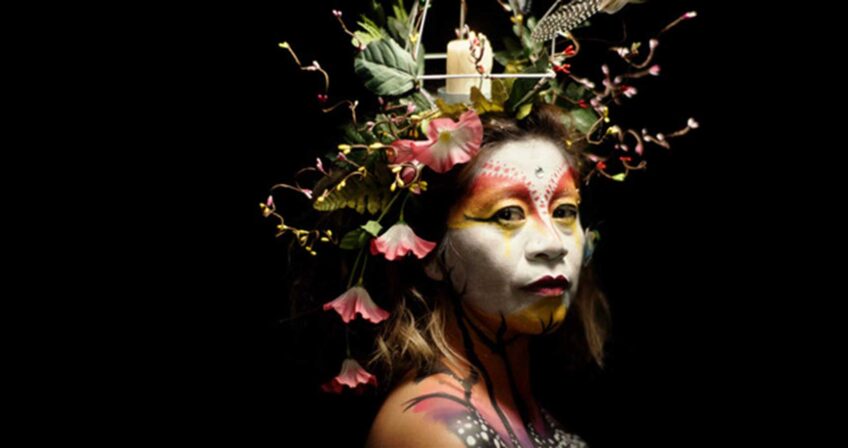A dance through time in “More Forever”
Caleb Teicher & Company celebrate, reinvent tap

The rhythm-driven art of tap, rooted in African American musical traditions, is inspiring a new generation of choreographers and dancers. And as they rise, their companies develop new performers who in turn become mentors for others.
Among the most prominent is Savion Glover, whose 1996 Broadway show “Bring in ’da Noise, Bring in ’da Funk” merged hip-hop and tap. Another is Michelle Dorrance, who launched her company, Dorrance Dance, with Dormeshia Sumbry-Edwards and won a 2011 Bessie Award for “blasting open our notions about tap.” Also winning a 2011 Bessie, for outstanding individual performance, was a little-known 18-year-old in her company, Caleb Teicher.
Last weekend, Teicher made his Boston debut with a program entitled “Caleb Teicher & Company with Conrad Tao,” presented by the Celebrity Series of Boston at the New England Conservatory Plimpton Shattuck Black Box Theatre.
The 250-seat theater offered an intimate setting for an hour-long work, “More Forever,” choreographed by Teicher with an original score for piano and electronics by Conrad Tao, a composer and pianist who performs on stage with the dancers.
Both Teicher and Tao are former teen prodigies and, now in their mid-20s, they are artists of worldwide renown who relish adventurous collaborations. New York Magazine has described Tao as “shaping the future of classical music,” and last year Dance Magazine named Teicher “Best Emerging Choreographer.”
Teicher and the six members of Caleb Teicher & Company (CT&Co) are steeped in American dance traditions and drawn to their endless capacity for reinvention. In “More Forever,” Teicher and his company combine Tao’s piano music with the sound and sight of sanding, a tap technique that predates metal-tipped shoes, as they explore American dance forms such as tap and the Harlem-born Lindy Hop.
In their hands, which strew the sound-sharpening grains across the stage, sand also becomes a visual cue — a shared marker of their common cause and also a reminder of time, as in an hourglass.
“More Forever” moves through time and the evolving cultural history of America. Celebrating street-honed dance traditions, the work also becomes an ode to the finite gift of time that allows and brackets all experiences — a poignant touch by these young artists, who have ample time to come.
The evening-length work’s minimalist staging focuses attention on the fundamentals — what the performers are doing. Lighting by Serena Wong and black attire by Márion Talán offer a chiaroscuro palette to suit the ample interplay of darkness and light in “More Forever.” As its scenes shift, dancers emerge and then disappear into a darkened stage. Wong’s lighting sculpts a pianist’s hands with pinpoint precision and illuminates dancers with circles and rectangles that expand and contract in size.
“More Forever” is a work of seamless collaboration, its pianist dancing with his keyboard and its dancers making music with their bodies.
The piece opens with a piano prelude by Tao, whose musical vocabulary is a foretaste of the dancing with its shifts in mood, tone and tempo — varying from pensive and melodic passages to clanging, high-energy bursts of sound, with silence in between.
Tao himself is a riveting performer, not only with his music but also, highlighted by Wong’s lighting, in the arc of his hands as they hover over the keys. And as he walks offstage or later sits Buddha-like on the floor and plucks a toy piano, its clinks keeping time with the dancers’ feet, his spare movement seems as choreographed as the dancing of his partners.
Soon Tao is joined by Teicher, who is first heard, not seen, on a darkened stage, as he injects into Tao’s piano solo the scraping rhythm of his feet sweeping sand across the surface of a custom-built platform. As the light rises, the sonic duet between feet and keyboard expands into a spectacular dance performance. Teicher’s feet scrape, crunch, stomp, ripple and scour the floor as he crosses the stage with daredevil prowess in leaps, lyrical loops, and rapid-fire legwork. Meanwhile, he sifts sand onto the floor, its grains falling in a column that, backlit, resembles a veil.
In ones and twos, the other dancers join Teicher, each strewing a column of sand. They move with their entire bodies, not, as in early tap, holding torsos still and only dancing with their feet. And like Teicher, they appear and then, on a darkened stage, disappear, only to return again. As they perform alone, in pairs, trios, or as an ensemble, their movement varies from exuberant, bravura leaps to intricate footwork. Their musical dialogues with Tao shift from pulsing unison phrases to multilayered passages, and often add clapping hands to thumping feet.
In one segment, three dancers line up, their backs to the audience. With legs straight as pendulum rods, they slide side-to-side, their scraping feet making a swinging, syncopated beat. In another scene, a couple loosely links in ballroom style. Sand drifting from their palms, they dance a swirling, angular duet that suggests a semi-abstract Lindy Hop.
Celebrating the dancers’ individuality, Teicher performs a duo with each member that comes across as a challenge, a showcase and an intimate encounter. He and his partner signal its start by snapping their fingers twice, a nod to the jitterbug.
These encounters, like all the elements in “More Forever,” are time-bound, captivating us only to disappear before our eyes into the dark. Concluding a work that is all about time, passing through and beyond dance history to reflect on time itself, Teicher ends with another virtuosic solo and a song, in which he laments, “I thought I would have more time.”






